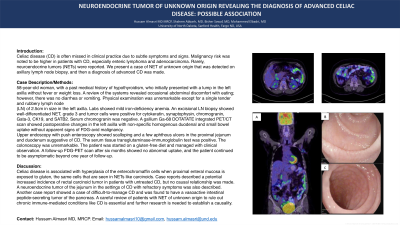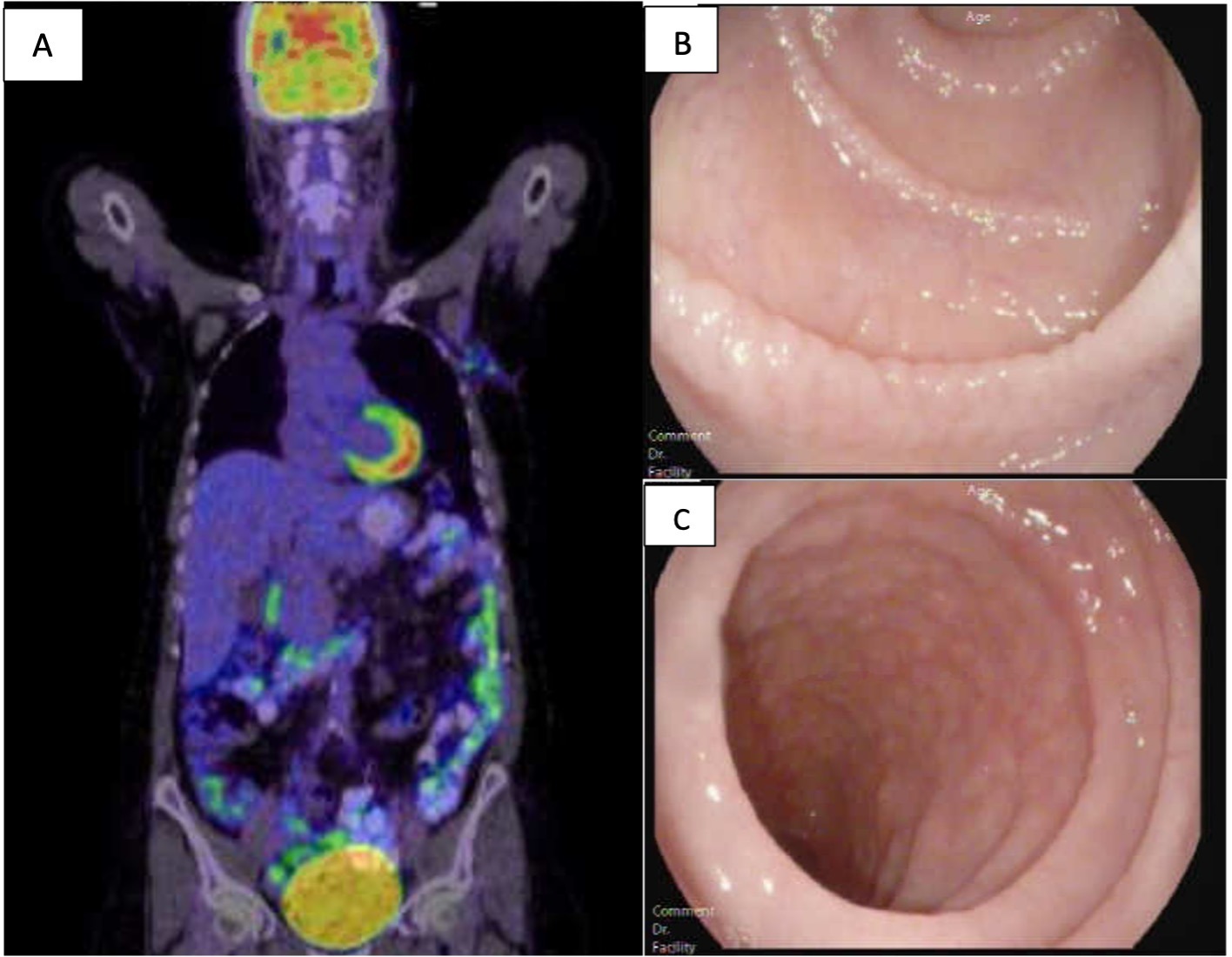Monday Poster Session
Category: Small Intestine
P3268 - Neuroendocrine Tumor of Unknown Origin Revealing the Diagnosis of Advanced Celiac Disease: Possible Association? A Case Report
Monday, October 28, 2024
10:30 AM - 4:00 PM ET
Location: Exhibit Hall E

Has Audio

Hussam Almasri, MD, MRCP
University of North Dakota
Fargo, ND
Presenting Author(s)
Hussam Almasri, MD, MRCP1, Shahem Abbarh, MD2, Bisher Sawaf, MD3, Mohammed Elbadri, MD2
1University of North Dakota, Fargo, ND; 2Hamad Medical Corporation, Doha, Ad Dawhah, Qatar; 3University of Toledo Health Sciences Campus, Toledo, OH
Introduction: Celiac disease (CD) is often missed in clinical practice due to subtle symptoms and signs. Malignancy risk was noted to be higher in patients with CD, especially enteric lymphoma and adenocarcinoma. Rarely, neuroendocrine tumors (NETs) were reported. We present a case of NET of unknown origin that was detected on axillary lymph node biopsy, and then a diagnosis of advanced CD was made.
Case Description/Methods: 58-year-old woman, with a past medical history of hypothyroidism, who initially presented with a lump in the left axilla without fever or weight loss. A review of the systems revealed occasional abdominal discomfort with eating; however, there was no diarrhea or vomiting. Physical examination was unremarkable except for a single tender and rubbery lymph node (LN) of 2.5cm in size in the left axilla. Labs showed mild iron-deficiency anemia. An excisional LN biopsy showed well-differentiated NET, grade 3 and tumor cells were positive for cytokeratin, synaptophysin, chromogranin, Gata-3, CK19, and SATB2. Serum chromogranin was negative. A gallium Ga-68 DOTATATE integrated PET/CT scan showed postoperative changes in the left axilla with non-specific homogenous duodenal and small bowel uptake without apparent signs of FDG-avid malignancy (Figure 1). Upper endoscopy with push enteroscopy showed scalloping and a few aphthous ulcers in the proximal jejunum and duodenum suggestive of CD. The serum tissue transglutaminase-immunoglobulin test was positive. The colonoscopy was unremarkable. The patient was started on a gluten-free diet and managed with clinical observation. A follow-up FDG-PET scan after six months showed no abnormal uptake and the patient continued to be asymptomatic beyond one year of follow-up.
Discussion: Celiac disease is associated with hyperplasia of the enterochromaffin cells when proximal enteral mucosa is exposed to gluten, the same cells that are seen in NETs like carcinoids. Case reports described a potential increased incidence of rectal carcinoid tumor in patients with untreated CD but no causal relationship was made. A neuroendocrine tumor of the jejunum in the settings of CD with refractory symptoms was also described. Another case report showed a case of difficult-to-manage CD and was found to have a vasoactive intestinal peptide-secreting tumor of the pancreas. A careful review of patients with NET of unknown origin to rule out chronic immune-mediated conditions like CD is essential and further research is needed to establish a causality.

Disclosures:
Hussam Almasri, MD, MRCP1, Shahem Abbarh, MD2, Bisher Sawaf, MD3, Mohammed Elbadri, MD2. P3268 - Neuroendocrine Tumor of Unknown Origin Revealing the Diagnosis of Advanced Celiac Disease: Possible Association? A Case Report, ACG 2024 Annual Scientific Meeting Abstracts. Philadelphia, PA: American College of Gastroenterology.
1University of North Dakota, Fargo, ND; 2Hamad Medical Corporation, Doha, Ad Dawhah, Qatar; 3University of Toledo Health Sciences Campus, Toledo, OH
Introduction: Celiac disease (CD) is often missed in clinical practice due to subtle symptoms and signs. Malignancy risk was noted to be higher in patients with CD, especially enteric lymphoma and adenocarcinoma. Rarely, neuroendocrine tumors (NETs) were reported. We present a case of NET of unknown origin that was detected on axillary lymph node biopsy, and then a diagnosis of advanced CD was made.
Case Description/Methods: 58-year-old woman, with a past medical history of hypothyroidism, who initially presented with a lump in the left axilla without fever or weight loss. A review of the systems revealed occasional abdominal discomfort with eating; however, there was no diarrhea or vomiting. Physical examination was unremarkable except for a single tender and rubbery lymph node (LN) of 2.5cm in size in the left axilla. Labs showed mild iron-deficiency anemia. An excisional LN biopsy showed well-differentiated NET, grade 3 and tumor cells were positive for cytokeratin, synaptophysin, chromogranin, Gata-3, CK19, and SATB2. Serum chromogranin was negative. A gallium Ga-68 DOTATATE integrated PET/CT scan showed postoperative changes in the left axilla with non-specific homogenous duodenal and small bowel uptake without apparent signs of FDG-avid malignancy (Figure 1). Upper endoscopy with push enteroscopy showed scalloping and a few aphthous ulcers in the proximal jejunum and duodenum suggestive of CD. The serum tissue transglutaminase-immunoglobulin test was positive. The colonoscopy was unremarkable. The patient was started on a gluten-free diet and managed with clinical observation. A follow-up FDG-PET scan after six months showed no abnormal uptake and the patient continued to be asymptomatic beyond one year of follow-up.
Discussion: Celiac disease is associated with hyperplasia of the enterochromaffin cells when proximal enteral mucosa is exposed to gluten, the same cells that are seen in NETs like carcinoids. Case reports described a potential increased incidence of rectal carcinoid tumor in patients with untreated CD but no causal relationship was made. A neuroendocrine tumor of the jejunum in the settings of CD with refractory symptoms was also described. Another case report showed a case of difficult-to-manage CD and was found to have a vasoactive intestinal peptide-secreting tumor of the pancreas. A careful review of patients with NET of unknown origin to rule out chronic immune-mediated conditions like CD is essential and further research is needed to establish a causality.

Figure: Figure 1 Gallium Ga-68 DOTATATE integrated PET/CT scan. B, C: Push enteroscopy showing scalloping and superficial erythema
Disclosures:
Hussam Almasri indicated no relevant financial relationships.
Shahem Abbarh indicated no relevant financial relationships.
Bisher Sawaf indicated no relevant financial relationships.
Mohammed Elbadri indicated no relevant financial relationships.
Hussam Almasri, MD, MRCP1, Shahem Abbarh, MD2, Bisher Sawaf, MD3, Mohammed Elbadri, MD2. P3268 - Neuroendocrine Tumor of Unknown Origin Revealing the Diagnosis of Advanced Celiac Disease: Possible Association? A Case Report, ACG 2024 Annual Scientific Meeting Abstracts. Philadelphia, PA: American College of Gastroenterology.
